一、实验目的
能够编写程序调用OpenDaylight REST API实现特定网络功能;
能够编写程序调用Ryu REST API实现特定网络功能。
三、实验要求
(一)基本要求
编写Python程序,调用OpenDaylight的北向接口实现以下功能
(1)利用Mininet平台搭建下图所示网络拓扑,并连接OpenDaylight;
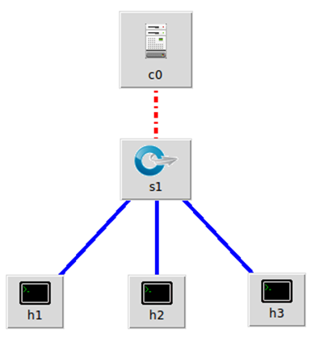
搭建拓扑 命令行输入
sudo mn --topo=single,3 --controller=remote,ip=127.0.0.1,port=6633 --switch ovsk,protocols=OpenFlow13
Beryllium 版本 连接OpenDaylight
./distribution-karaf-0.4.4-Beryllium-SR4/bin/karaf
feature:install odl-restconf odl-l2switch-switch-ui odl-openflowplugin-all odl-mdsal-apidocs odl-dlux-core odl-dlux-node odl-dlux-yangui
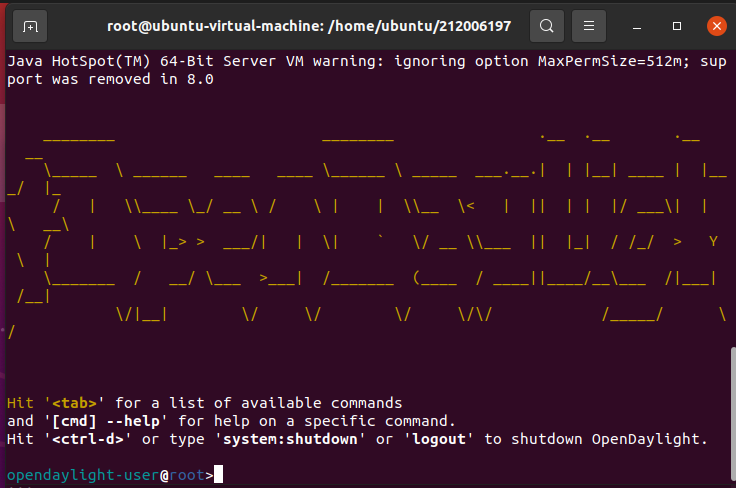
(2) 下发指令删除s1上的流表数据。
创建并编写delete.py文件
#!/usr/bin/python
import requests
from requests.auth import HTTPBasicAuth
def http_delete(url):
url = url
headers = {'Content-Type':'application/json'}
resp = requests.delete(url,headers=headers,auth=HTTPBasicAuth('admin', 'admin'))
return resp
if __name__ == "__main__":
url = 'http://127.0.0.1:8181/restconf/config/opendaylight-inventory:nodes/node/openflow:1/'
resp = http_delete(url)
print (resp.content)
(3) 下发硬超时流表,实现拓扑内主机h1和h3网络中断20s。
创建并编写 timeout.py 文件
#!/usr/bin/python
import requests
from requests.auth import HTTPBasicAuth
def http_put(url,jstr):
url = url
headers = {'Content-Type':'application/json'}
resp = requests.put(url,jstr,headers=headers,auth=HTTPBasicAuth('admin', 'admin'))
return resp
if __name__ == "__main__":
url = 'http://127.0.0.1:8181/restconf/config/opendaylight-inventory:nodes/node/openflow:1/flow-node-inventory:table/0/flow/1'
with open("./timeout.json") as f:
jstr = f.read()
resp = http_put(url,jstr)
print (resp.content)
创建并编写 timeout.json 文件
{
"flow": [
{
"id": "1",
"match": {
"in-port": "1",
"ethernet-match": {
"ethernet-type": {
"type": "0x0800"
}
},
"ipv4-destination": "10.0.0.3/32"
},
"instructions": {
"instruction": [
{
"order": "0",
"apply-actions": {
"action": [
{
"order": "0",
"drop-action": {}
}
]
}
}
]
},
"flow-name": "flow",
"priority": "65535",
"hard-timeout": "20",
"cookie": "2",
"table_id": "0"
}
]
}
h1 ping h3
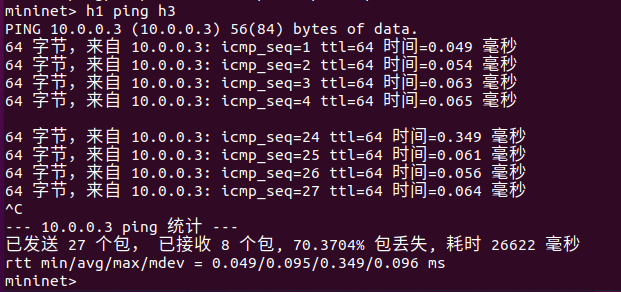
(4) 获取s1上活动的流表数
创建并编写 getflow.py 文件
#!/usr/bin/python
import requests
from requests.auth import HTTPBasicAuth
def http_get(url):
url = url
headers = {'Content-Type':'application/json'}
resp = requests.get(url,headers=headers,auth=HTTPBasicAuth('admin', 'admin'))
return resp
if __name__ == "__main__":
url = 'http://127.0.0.1:8181/restconf/operational/opendaylight-inventory:nodes/node/openflow:1/flow-node-inventory:table/0/opendaylight-flow-table-statistics:flow-table-statistics'
resp = http_get(url)
print (resp.content)
2.编写Python程序,调用Ryu的北向接口实现以下功能
(1) 实现上述OpenDaylight实验拓扑上相同的硬超时流表下发
创建并编写 ryu_timeout.py 文件
#!/usr/bin/python
import requests
from requests.auth import HTTPBasicAuth
def http_post(url,jstr):
url = url
headers = {'Content-Type':'application/json'}
resp = requests.post(url,jstr,headers=headers)
return resp
if __name__ == "__main__":
url = 'http://127.0.0.1:8080/stats/flowentry/add'
with open("./timeout_ryu.json") as f:
jstr = f.read()
resp = http_post(url,jstr)
print (resp.content)
创建并编写 ryu_timeout.json 文件
{
"dpid": 1,
"cookie": 1,
"cookie_mask": 1,
"table_id": 0,
"hard_timeout": 20,
"priority": 65535,
"flags": 1,
"match":{
"in_port":1
},
"actions":[
]
}
启动ryu控制器
ryu-manager ryu.app.simple_switch_13 ryu.app.ofctl_rest
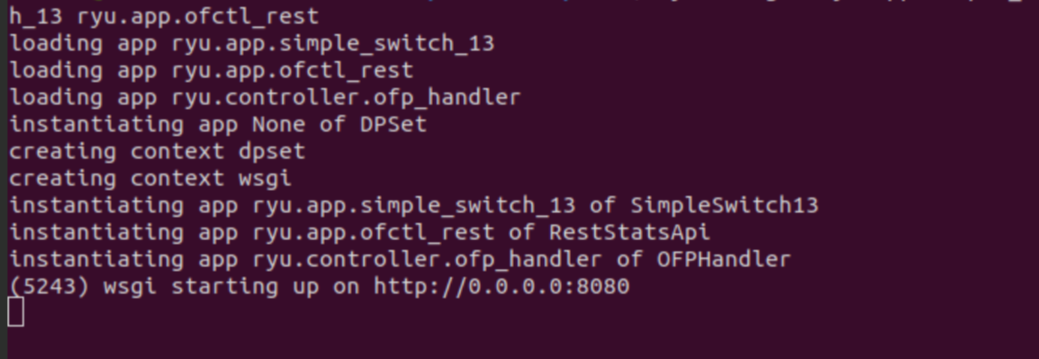
创建拓扑
sudo mn --topo=single,3 --mac --controller=remote,ip=127.0.0.1,port=6633 --switch ovsk,protocols=OpenFlow13022.cnblogs.com/blog/2965914/202211/2965914-20221106162904590-744390023.png)
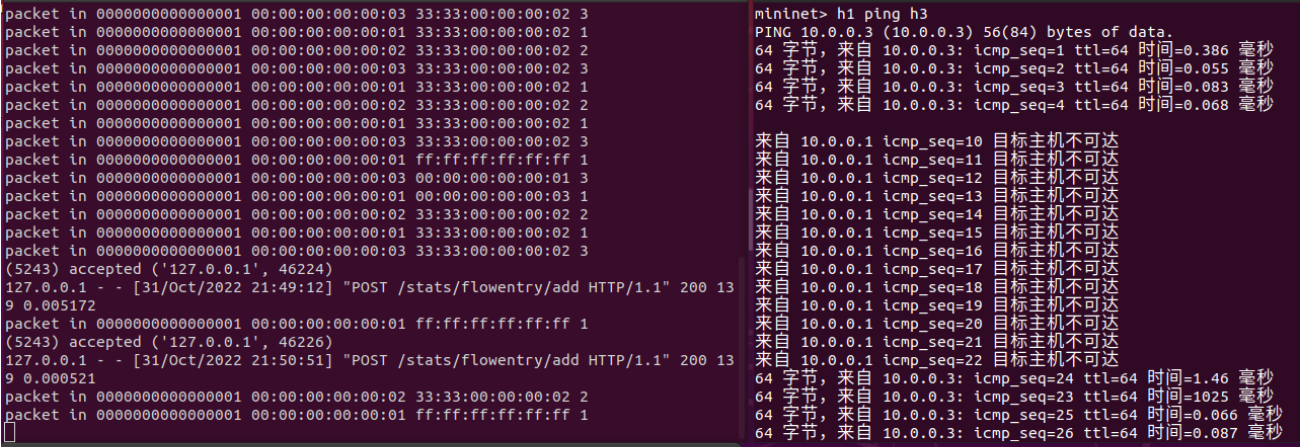
(2) 参考Ryu REST API的文档,基于VLAN实验的网络拓扑,编程实现相同的VLAN配置
创建并编写 ryu_topo.py 文件
# ryu_topo.py
from mininet.topo import Topo
class MyTopo(Topo):
def __init__(self):
# initilaize topology
Topo.__init__(self)
self.addSwitch("s1")
self.addSwitch("s2")
self.addHost("h1")
self.addHost("h2")
self.addHost("h3")
self.addHost("h4")
self.addLink("s1", "h1")
self.addLink("s1", "h2")
self.addLink("s2", "h3")
self.addLink("s2", "h4")
self.addLink("s1", "s2")
topos = {'mytopo': (lambda: MyTopo())}
创建并编写 ryu_vlan.py 文件
# ryu_vlan.py
import json
import requests
if __name__ == "__main__":
url = 'http://127.0.0.1:8080/stats/flowentry/add'
headers = {'Content-Type': 'application/json'}
flow1 = {
"dpid": 1,
"priority": 1,
"match":{
"in_port": 1
},
"actions":[
{
"type": "PUSH_VLAN",
"ethertype": 33024
},
{
"type": "SET_FIELD",
"field": "vlan_vid",
"value": 4096
},
{
"type": "OUTPUT",
"port": 3
}
]
}
flow2 = {
"dpid": 1,
"priority": 1,
"match":{
"in_port": 2
},
"actions":[
{
"type": "PUSH_VLAN",
"ethertype": 33024
},
{
"type": "SET_FIELD",
"field": "vlan_vid",
"value": 4097
},
{
"type": "OUTPUT",
"port": 3
}
]
}
flow3 = {
"dpid": 1,
"priority": 1,
"match":{
"vlan_vid": 0
},
"actions":[
{
"type": "POP_VLAN",
"ethertype": 33024
},
{
"type": "OUTPUT",
"port": 1
}
]
}
flow4 = {
"dpid": 1,
"priority": 1,
"match": {
"vlan_vid": 1
},
"actions": [
{
"type": "POP_VLAN",
"ethertype": 33024
},
{
"type": "OUTPUT",
"port": 2
}
]
}
flow5 = {
"dpid": 2,
"priority": 1,
"match": {
"in_port": 1
},
"actions": [
{
"type": "PUSH_VLAN",
"ethertype": 33024
},
{
"type": "SET_FIELD",
"field": "vlan_vid",
"value": 4096
},
{
"type": "OUTPUT",
"port": 3
}
]
}
flow6 = {
"dpid": 2,
"priority": 1,
"match": {
"in_port": 2
},
"actions": [
{
"type": "PUSH_VLAN",
"ethertype": 33024
},
{
"type": "SET_FIELD",
"field": "vlan_vid",
"value": 4097
},
{
"type": "OUTPUT",
"port": 3
}
]
}
flow7 = {
"dpid": 2,
"priority": 1,
"match": {
"vlan_vid": 0
},
"actions": [
{
"type": "POP_VLAN",
"ethertype": 33024
},
{
"type": "OUTPUT",
"port": 1
}
]
}
flow8 = {
"dpid": 2,
"priority": 1,
"match": {
"vlan_vid": 1
},
"actions": [
{
"type": "POP_VLAN",
"ethertype": 33024
},
{
"type": "OUTPUT",
"port": 2
}
]
}
res1 = requests.post(url, json.dumps(flow1), headers=headers)
res2 = requests.post(url, json.dumps(flow2), headers=headers)
res3 = requests.post(url, json.dumps(flow3), headers=headers)
res4 = requests.post(url, json.dumps(flow4), headers=headers)
res5 = requests.post(url, json.dumps(flow5), headers=headers)
res6 = requests.post(url, json.dumps(flow6), headers=headers)
res7 = requests.post(url, json.dumps(flow7), headers=headers)
res8 = requests.post(url, json.dumps(flow8), headers=headers)
启动Ryu控制器
ryu-manager ryu.app.simple_switch_13 ryu.app.ofctl_rest
创建拓扑
sudo sudo mn --custom ryu_topo.py --topo mytopo --mac --controller=remote,ip=127.0.0.1,port=6633 --switch ovsk,protocols=OpenFlow13
删除流表
curl -X DELETE http://127.0.0.1:8080/stats/flowentry/clear/1
curl -X DELETE http://127.0.0.1:8080/stats/flowentry/clear/2
运行python ryu_vlan.py
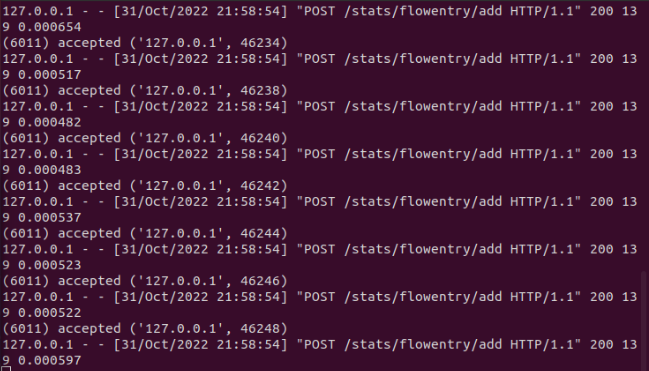

个人总结
调用Ryu的北向接口实现硬超时流表下发前创建拓扑无法ping通
解决方案:建立拓扑时应该使用OpenFlow1.3,使用OpenFlow1.0会出现无法ping通的情况。
本次实验的实验内容主要内容在先前实验的基础上进行,泵且在实验难度上提升,所以本次实验所耗费时间相对较久。但同时也让我对于Open DayLight 和 Ryu的使用和北向API都有了更加深刻的了解,对于request包的使用更加熟悉。


 posted on
posted on

 浙公网安备 33010602011771号
浙公网安备 33010602011771号